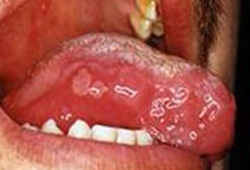History and exam
Key diagnostic factors
common
increased predisposition in certain ethnic/geographic groups
Seen commonly in the Middle East, eastern Asia, and around the Mediterranean. There is evidence for genetic anticipation (i.e., the next generation gets the symptoms earlier and in a more severe form).[15]
oral ulcers
Unlike herpes ulcers, these lesions are always in the moist mucosal surfaces inside the mouth and do not occur on the outer surfaces of the lips.[Figure caption and citation for the preceding image starts]: Mouth ulcerFrom the collection of Yusuf Yazici, MD [Citation ends].
genital ulcers
Can be painful and scar, especially when on the scrotum.
Tend to get infected, which interferes with the healing process.
Penis is usually spared.
uveitis
Panuveitis subtype is the leading cause of morbidity. It is more common, and has a more severe course, in men.
acne lesions
Identical to acne vulgaris lesions but may arise in atypical locations (e.g., the arms and legs).
erythema nodosum
Nodular lesions, difficult to differentiate from superficial thrombophlebitis.
Usually on the lower extremities and tend to resolve in 1-2 weeks.
limited duration of symptoms
Unlike other rheumatic conditions, symptoms in Behcet's syndrome tend to abate with time.
The likelihood of developing new areas of involvement in most organ systems also decreases with time, except for central nervous system (CNS) and vascular involvement.
CNS and vascular involvement can develop with similar frequency at any point in the course of the condition.[7]
superficial thrombophlebitis
Associated with deep vein thrombosis and pulmonary aneurysm formation.
hypopyon
Precipitation of inflammatory cells in the anterior chamber indicates severe inflammation in the eye. Hypopyon is virtually pathognomonic.[3]
uncommon
stroke
Untreated central nervous system vascular disease in Behcet's syndrome can lead to stroke.[6]
eye pain, blurry vision, photophobia, or photosensitivity
May indicate uveitis.
memory loss
A common feature of parenchymal central nervous system involvement.
headache, confusion, or fever
Meningeal inflammation can be a complication of Behcet's syndrome and may manifest with all the signs and symptoms of meningoencephalitis.[4]
haemoptysis, cough, shortness of breath, or chest pain
May suggest pulmonary involvement, such as a pulmonary aneurysm, which can be life-threatening.
eye redness or tearing
May indicate uveitis.
impaired speech, balance, or movement
Parenchymal central nervous system involvement can include meningeal irritation, white matter changes, and inflammation.
Other diagnostic factors
uncommon
cramping abdominal pain, diarrhoea, or gastrointestinal ulceration
Gastrointestinal symptoms may be confused with inflammatory bowel conditions, especially Crohn's disease.
Risk factors
strong
age 20-40 years
Most patients present in their 20s and 30s. It is uncommon before puberty and in those aged >70 years.
family history of Behcet's syndrome
Contributes to approximately 20% of cases. Complex non-Mendelian inheritance patterns.[14]
genetic predisposition
Seen more commonly in the Middle East, eastern Asia, and around the Mediterranean. There is evidence for genetic anticipation (i.e., the next generation gets the symptoms earlier and in a more severe form).[15]
Use of this content is subject to our disclaimer